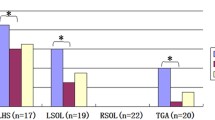Abstract
The relationship between pulsatility index (PI) in the middle cerebral artery (MCA) and adverse perinatal outcome was studied in 162 normal and 75 high-risk pregnancies. The intrapartum cardiotocographic (CTG) findings, the mode of delivery, 1 and 5-minute Apgar scores, the pH level of the umbilical artery, admission to the neonatal intensive care unit (NICU) and the incidence of intrauterine fetal growth retardation were recorded. In the low risk group, the PI values in the MCA were only affected in growth retarded fetuses (P = 0.0084). In the high-risk group, there was an association between the MCA PI values and 5-minute Apgar scores (P = 0.0397), umbilical artery pH values (P = 0.0068) and development of IUGR (P = 0.0376). In both groups, an abnormal intrapartum CTG, the 1-minute Apgar score, cesarean section for fetal distress and admission to the NICU were not related to PI values in the MCA. Our present study suggests that doppler flow measurement of MCA provides useful information about perinatal outcome, especially in the high-risk pregnancies.
Similar content being viewed by others
References
Fitzgerald DE, Drumm JE (1977) Noninvasive measurement of human fetal circulation using ultrasound, a new method. Br Med J 2:1450–1451
Berkowitz GS, Mehalek KE, Chitkara U, Rosenberg J, Cogswell C, Berkowitz RL (1988) Doppler umbilical velocimetry in the prediction of adverse outcome in pregnancies at risk for intrauterine growth retardation. Obstet Gynecol 71:742–746
Trudinger BJ, Cook CM, Giles WB, Fong E, Connely A, Wilcox W (1991) Fetal umbilical artery velocity waveforms and subsequent neonatal outcome. Br J Obstet Gynecol 98: 378–384
Cohn HE, Sacks EJ, Heymann MA, Rudolph AM.(1974) Cardiovascular responses to hypoxemia and acidemia in fetal lambs. Am J Obstet Gynecol 120:817–824
Trudinger BJ, Giles WB, Cook CM, Bombardieri J, Collins L (1985) Fetal umbilical artery flow velocity waveforms and placental resistance: clinical significance. Br J Obstet Gynecol 92:23–30
Peeters LLH, Sheldon RE, Jones MD, Makowski EL, Meschisa G (1979) Blood flow to fetal organs as a function of arterial content. Am J Obstet Gynecol 135:637–646
Ferrazzi E, Gementi P, Bellotti M, et al. (1990) Doppier velocimetry: critical analysis of umbilical, cerebral and aortic reference values. Eur J Obstet Gynecol Reprod Biol 38:189–196
Usher R, Mc Lean F (1969) Intrauterine growth of live-born Caucasion infants at sea level: standarts obtained from measurements in 7 dimensions of infants born between 25 and 44 weeks of gestation. J Pediatr 74:901–910
Bada HS, Hajjar W, Chua C, Sumner DS (1979) Noninvasive diagnosis of neonatal asphyxia and intraventricular hemorrhage by doppler ultrasound. J Pediatr 95:775–779
Woo JSK, Liang ST, Lo RSL, Chan FY (1987) Middle cerebral artery doppler flow velocity waveforms. Obstet Gynecol 70:613–616
Kirkinen P, Müller R, Huch R, Huch A (1987) Blood flow velocity waveforms in human fetal intracranial arteries. Obstet Gynecol 70:617–621
Hata K, Hata T, Makihara K, Aoki S, Takamiya O, Kitao M(1991) Fetal intracranial arterial hemodynamics assessed by color and pulsed doppler ultrasound. Int J Gynecol Obstet 35:139–145
Wladimiroff JW, Wijngaard JAGW van den, Degani S, Noordam MJ, Eyck J van, Tonge HM (1987) Cerebral and umbilical arterial blood flow velocity waveforms in normal and growth retarded pregnancies. Obstet Gynecol 69:705–709
Wladimiroff JW, Tonge HM, Stewart PA (1986) Doppler ultrasound assessment of cerebral blood flow in the human fetus. Br J Obstet Gynecol 93:471–745
Campbell S, Vyas S, Nicolaides KH (1991) Doppler investigation of the fetal circulation. J Perinat Med 19:21–26
Echizenya N, Kagiya A, Tachizahi T, Saito Y (1989) Significance of velocimetry as a monitor of fetal assessment and management. Fetal Ther 4:188–194
Gregg AR, Weiner CP (1993) “Normal” Umbilical arterial and venous acid-base and blood gas values. Clin Obstet Gynecol 36:24–32
Author information
Authors and Affiliations
Rights and permissions
About this article
Cite this article
Alataş, C., Aksoy, E., Akarsu, C. et al. Prediction of perinatal outcome by middle cerebral artery doppler velocimetry. Arch Gynecol Obstet 258, 141–146 (1996). https://doi.org/10.1007/s004040050115
Received:
Accepted:
Issue Date:
DOI: https://doi.org/10.1007/s004040050115




